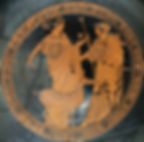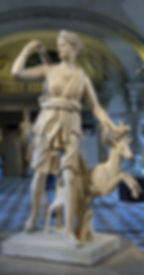Faces of a Goddess: Artemis
- Lujza Varga
- Jan 10, 2022
- 7 min read
Updated: Jan 17, 2022
In ancient civilizations, adapting or fusing deities was a common phenomenon. The most well-known is the direct continuity between the Greek and Roman mythology, yet, this tradition goes back way earlier and has an impact on art and culture even today: the characters of ancient mythologies inspire the imagination of modern man as well, and they appear in literature, music, fine arts and even pop culture (it is enough to mention Marvel Universe o Assassin's Creed).
From this cultural field, Artemis is one of the most interesting characters. Her name is well known both in her Greek (Artemis) and Roman form (Diana), which reflects on different descriptions and attributes that vary from place to place. Although this virgin deity had many faces, she possessed an unbroken vogue through the millennia.

Artemis was a central figure in the Greek mythology, just as there were lots of different stories of her in the Mediterranean (Graves, 1981). She was the daughter of Zeus and Leto, the twin sister of Apollo. She was the virgin goddess of hunt, wild nature, the Moon and childbirth, and the protector of virgin girls, wild animals and wilderness, and she gave horrible punishment for those who killed her sacred animals. She was often referred to as agrotera (which means ‘the wild one’), as agne (means ‘the pure') or parthenia (which means ‘the virgin’), while she was usually depicted as a hunter with arrows and bow, surrounded by wild animals, most often by stags (Hughes, 1990).

As she was one of the most popular gods, there were temples and sanctuaries dedicated to her all over the ancient world from Sardis to Sparta, while the Artemision in Ephesus (located in Asia Minor, now Turkey) was amongst the Seven Wonders of the Ancient World. During this period, the cult of Artemis also existed in Palestine, Transjordan, and Coele-Syria (Kampen, 2003). The cult of the goddess usually changed from place to place, and her name also changed: Artemis Agrotera, Artemis Hagratera, Artemis Orthia, Ephesian Artemis, etc.
Although there were great differences regarding her functions and cults by areas – Artemis Agrotera e. g. had a strong military side and thus was displayed before the battle of Marathon (Paradiso, 2016) – the permanency amongst these characteristics was the female deity of wild animals, who danced and hunted in wild nature.
As a main deity in the ancient world she also appeared in the Iliad, where she was called the ‘Mistress of the Animals’ (Britannica, 2022), reflecting another popular form of the goddess: Potnia Theron.

This figure, the 'Mistress of the Animals' (Potnia Theron) is known in ancient Minoan, Mycenaean, Greek and Etruscan art as well, often called as 'Mistress of Beasts' or 'Mistress of Wild Things' too, and always depicted with animals. A similar figure is known in the ancient Middle East as well, although their sameness is yet to be proven (John, 2022). A good point of connection can be, however, Artemis Orthia and Artemis of Ephesus, as they show similar renderings.
Artemis Orthia is most likely a merge of Artemis and Orthia, a Spartan winged animal goddess of women and fertility (National Museums Liverpool, 2022). As the cult of Orthia was only known in Sparta, it seems that she was a local goddess, who fused with the popular deity, Artemis. The Sanctuary of Artemis Orthia was built in the 9th century BCE and was first rebuilt in the 7th century BCE (Muscato, 2017). Small votive figurines of the winged goddess are known from the site of the sanctuary (The Met Collection, 2022).
The Artemis of Ephesus also had an unusual appearance, even though the Artemision (or Artemisium) of Ephesus was one of the most popular places of the ancient world. This great temple was a site for cults and pilgrimage, attracting ten thousands of people every year (UNESCO, 2021) and the greatest leaders of the then-known world were also amongst these: e.g. King Croesus and Alexander the Great. The cult of the goddess has been imbibed in the whole life of the city: she was ceremonially enthroned even to oversee the plays in the theatre (Kampen, 2003).

Although unfortunately the Artemision was completely ruined around 401 AD (Temple of Artemis, 2021) leaving hardly anything behind, copies of the famous Ephesian Artemis statues and some originals can be found in the Archaeological Museum while visiting the site of Ephesus.
The Artemis of Ephesus is unusual because the cult of a female god was rooted in that territory before as well: the indigenous people worshipped Cybele, the Anatolian fertility goddess, who later was identified with Artemis by the Ionian settlers, reshaping, yet maintaining the existing cult (Matthews, 2014). Artemis of Ephesus was depicted as a standing woman, whose chest was fully covered by unidentified objects: most likely the testicles of a bull or gourds, which were fertility symbols in Asia. Artemis' robe was decorated with wild animals: lions, leopards, goats, griffins, and bulls, which represented the 'Mistress of the Animals', Potnia Theron (Livius.org, 2019).
The Beautiful Artemis and the Big Artemis. Statues representing Artemis of Ephesus. Ephesus Archaeological Museum, Selcuk. Photos taken by the author in 2021.
The cult of Artemis survived in the upcoming centuries as well, as she was fused with the Roman goddess Diana. Her appearance in the Aeneid under the name of Diana as a virgin huntress with a bow, (Fratantuono, 2006) guaranteed the survival of her central role. Her temples were still amongst the most popular ones, even though the cult changed a bit: for example, in Sardis the Artemis' temple incorporated the Imperial Cult as well, providing space for numerous colossal portraits of the Roman emperors too (Fikret, 2010).

From the time of the Roman Empire onwards, we can find both the names ‘Diana’ and ‘Artemis’, and although the goddess has lost its deity during the Christian era, her figure constantly appeared in the cultural life and kept on inspiring literature and fine arts. This figure, however, was based purely on the classical description of the goddess of hunt and Moon, completely leaving Potnia Theron behind.
Thus, e.g. an automaton figuring Diana and a Stag could be created in the middle of the 17th century, when automatons were such novelties that could not only entertain their owners and their guests with their moving parts, but also served as special and expensive gifts (Diana and the Stag - The Met, 2022).

As the Western World is strongly based on Hellenistic traditions (Straub, 2018), it is no wonder why their societies were constantly reflecting on the characters of ancient mythology as well. That is how Saint-Gaudens selected Diana as her model when creating a statue, which could serve as a rotating weathervane for the tower of Madison Square Garden. As the tower itself was demolished in 1925 the statue is now at The Met (Diana - The Met, 2022).

The figure of Artemis even appears in feminist art (Eller, 2000), and although the character of the strong yet beautiful Wonder Woman is not specially based on the goddess, yet she surely gave her name (Diana), and in the Comic Books a rival character called Artemis emerges as well. Like this, Artemis has secretly entered pop culture too. Not so secret as much as her presence in the science, however: the name Artemis is quite common, when it is a question of naming new products in connection with biological, military or spaceflight projects (Artemis, 2022).

One of the most important is the Artemis program introduced by NASA, which intends to land the first woman and first person of colour on the Moon (NASA, 2022).
As the first NASA mission to send humans to the Moon was called Apollo, it is not shocking, that the second one is named after Apollo’s twin sister, the Moon goddess Artemis. This naming has also another important aim: to show its plan to involve at least one female astronaut.
The Artemis program’s mission is to establish the first lunar base: a permanent human settlement similar to the International Space Station (ISS). The lunar base’s long-term mission is to be resting point for missions whose aim is to send humans to Mars.

As such, the figure of the goddess of hunt, wild animals and Moon could preserve its ability to inspire humans for thousands of years.
References
1. Graves, Robert. (1981). A görög mítoszok. Budapest: Európa Könyvkiadó.
2. Hughes, Donald J. (1990). Goddess of Conservation. Forest & Conservation History 34 (4), 191-197.
3. Kampen, John. (2003). The Cult of Artemis and the Essenes in Syro-Palestine. Dead Sea Discoveries 10 (2), 205-220.
4. Paradiso, Annalisa. (2016). Aristodemus ‘The Good’ and the Temple of Artemis Agrotera at Megapolis. The Classical Quarterly, New Series 66 (1), 128-133.
5. Artemis. Greek goddess. In Britannica. Retrieved from https://www.britannica.com/topic/Artemis-Greek-goddess
6. John, David. (2022). Mistress of Animals. Ancient Greek mythology, religion and art. My Favourite Planet. Retrieved from http://www.my-favourite-planet.de/english/people/m1/mistress-of-animals.html
7. Who was Artemis-Orthia? (2022) National Museums Liverpool. Retrieved from https://www.liverpoolmuseums.org.uk/stories/who-was-artemis-orthia
8. Muscato, Christopher. (2017). The Sanctuary of Artemis Orthia: History & Temple. Study.com, Retrieved from study.com/academy/lesson/the-sanctuary-of-artemis-orthia-history-temple.html
9. Lead figure of a winged goddess, possibly Artemis Orthia. (2021) The Met. Retrieved from https://www.metmuseum.org/art/collection/search/251612
10. Ephesus. World Heritage List. UNESCO Retrieved from https://whc.unesco.org/en/list/1018/
11. Temple of Artemis. Wikipedia Retrieved from https://en.wikipedia.org/wiki/Temple_of_Artemis#Cult_and_influence
12. Matthews, Henry. (2014). Greco-Roman Cities of Aegean Turkey. History, Archaeology, Architecture. Istanbul: Ege Yayinlari, 207-253.
13. Artemis of Ephesus. (2019) Livius.org. Articles on Ancient History. Retrieved from https://www.livius.org/articles/religion/artemis-of-ephesus/
14. Fratantuono, Lee M. (2006). Diana in the “Aineid”. Quaderni Urbinati di Cultura Classica – New Series 83 (2), 29-43.
15. Fikret, Yegül. (2010). The Temple of Artemis at Sardis. In.: Cahill, Nicholas, D. (Ed): The Lydians and their World. Retrieved from https://sardisexpedition.org/en/essays/latw-yegul-temple-of-artemis
16. Joachim Friess: Diana and the Stag. ca. 1620. The Metropolitan Museum of Art. Retrieved from https://www.metmuseum.org/art/collection/search/193623
17. Diana. Viewpoints: Body Language. The Metropolitan Museum of Art. Retrieved from https://www.metmuseum.org/art/online-features/viewpoints/diana
18. Straub, Eberhard. (2018). Az élő város. Az urbánus életformák változásai. Budapest: Typotex.
19. Eller, Cynthia. (2000). Divine Objectification: The Representation of Goddesses and Women in Feminist Spirituality. Journal of Feminist Studies in Religion 16 (1), 23-44.
20. Artemis. Wikipedia. Retrieved from https://en.wikipedia.org/wiki/Artemis_(disambiguation)
21. Artemis. NASA. Retrieved from https://www.nasa.gov/specials/artemis/
Pictures
Guillaume Seignac: Diana, The Huntress. FineArtAmerica. https://fineartamerica.com/featured/diana-the-huntress-guillaume-seignac.html
The reconstruction of the Statue of Artemis Agrotera. Assassins Creed. https://assassinscreed.fandom.com/wiki/Statue_of_Artemis_Agrotera
Apollo and Artemis. Apollo (left) and Artemis (right). Brygos (potter, signed), Briseis Painter, Tondo of an Attic red-figure cup, ca. 470 BCE, Louvre. https://en.wikipedia.org/wiki/Artemis#/media/File:Apollo_Artemis_Brygos_Louvre_G151.jpg
Daedalic Pendant with Potnia Theron (Mistress of the Animals). 650-600 BC. The Cleveland Museum of Art. https://www.clevelandart.org/art/2001.157
The reconstruction of the Artemision by Rocío Espín Pinar. https://rocioespin.artstation.com/projects/BmWXy9
The Beautiful Artemis and the Big Artemis. Photos taken by the author in 2021.
Diana of Versailles. A partially restored Roman copy of a Greek statue. Musée du Louvre. https://en.wikipedia.org/wiki/Artemis#/media/File:Diana_of_Versailles.jpg
Joachim Friess: Diana and the Stag. ca. 1620. The Met. https://www.metmuseum.org/art/collection/search/193623
Augustus Saint-Gaudens (American, Dublin 1848–1907 Cornish, New Hampshire). Diana, 1893–94, cast 1894 or after. Bronze. The Metropolitan Museum of Art, New York, Purchase, Gift of Lincoln Kirstein, 1985 (1985.353).
Artemis. NASA. https://blogs.nasa.gov/artemis/
Illustration of NASA astronauts on the lunar South Pole. Credit: NASA. https://blogs.nasa.gov/artemis/2020/10/28/lunar-living-nasas-artemis-base-camp-concept/










